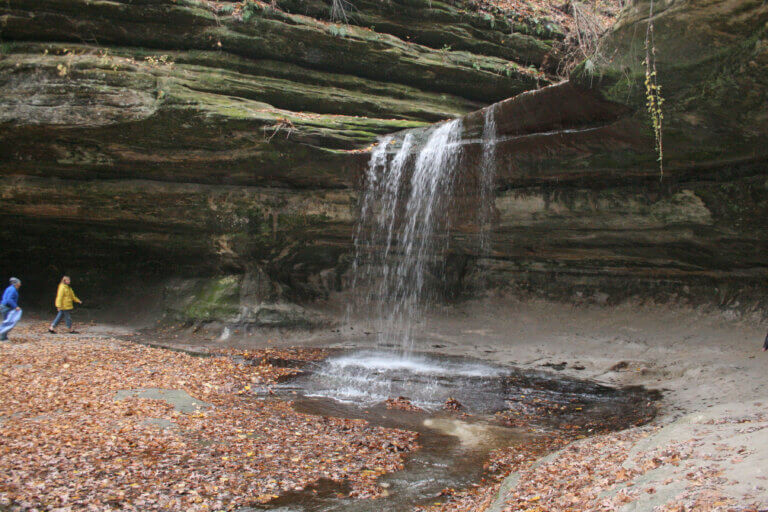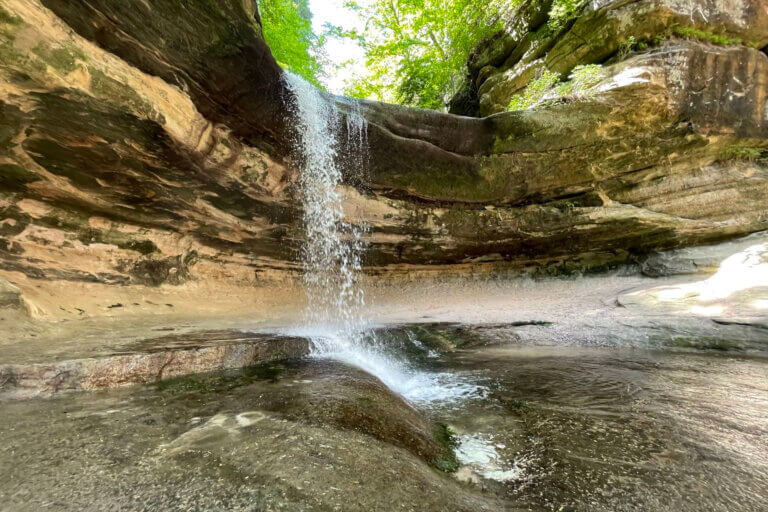Starved Rock State Park, Illinois, is nestled along the Illinois River in LaSalle County, offering stunning natural beauty and historical significance; rockscapes.net invites you to explore its scenic trails and majestic canyons. Discover the perfect blend of adventure and tranquility in this iconic Midwest destination and get inspired for your own landscaping projects using natural elements.
1. What Makes Starved Rock State Park in Illinois Special?
Starved Rock State Park in Illinois is special because of its unique geological features, including 18 canyons formed by glacial meltwater, stunning waterfalls that flow primarily in the spring and after heavy rains, and dramatic sandstone bluffs overlooking the Illinois River. The park also boasts 13 miles of well-maintained hiking trails that wind through these natural wonders, offering visitors a chance to immerse themselves in the beauty of the Illinois landscape. According to the Illinois Department of Natural Resources, the park’s diverse ecosystem supports a wide variety of plant and animal life, making it a haven for nature lovers and outdoor enthusiasts.
- Canyons and Waterfalls: The defining features of Starved Rock are its 18 canyons, each with its own unique charm. These canyons were carved out by glacial meltwater over thousands of years, creating picturesque waterfalls that cascade down the sandstone cliffs, especially during the spring thaw and after significant rainfall.
- Hiking Trails: With 13 miles of trails, the park offers a range of hiking experiences, from easy strolls along the river to more challenging climbs into the canyons. These trails provide access to iconic spots like Starved Rock, Eagle Cliff, and Wildcat Canyon, each offering breathtaking views.
- Historical Significance: The park’s name comes from a Native American legend, adding a layer of historical depth to the natural beauty. This blend of natural and cultural history makes Starved Rock a compelling destination for all types of visitors.
2. Where Exactly Is Starved Rock State Park Located in Illinois?
Starved Rock State Park is located in LaSalle County, Illinois, specifically at 2668 East 875th Road, Oglesby, IL 61348. The park is situated along the scenic Illinois River, making it easily accessible for those coming from major cities like Chicago, which is approximately a 90-mile drive away. Its central location in northern Illinois makes it a popular destination for weekend getaways and day trips.
- Accessibility: Starved Rock’s proximity to major highways and cities makes it a convenient escape for urban dwellers seeking a natural retreat. The well-maintained roads leading to the park ensure a smooth and easy drive.
- Surrounding Area: The park is surrounded by other natural and historical attractions, including Matthiessen State Park and the historic town of Utica, offering visitors a chance to explore more of the region’s rich heritage and natural beauty.
- GPS Coordinates: For precise navigation, the GPS coordinates for Starved Rock State Park are 41.3234° N latitude and 89.0045° W longitude.
3. What Activities Can You Do at Starved Rock State Park?
Starved Rock State Park offers a wide range of activities for nature lovers and adventure seekers, including hiking, camping, fishing, and picnicking. The park’s diverse landscape provides the perfect backdrop for outdoor adventures and memorable experiences.
- Hiking and Trail Exploration: Hiking is the most popular activity at Starved Rock, with trails ranging from easy to challenging. Explore the various canyons, such as St. Louis Canyon and French Canyon, each featuring unique geological formations and seasonal waterfalls. Don’t miss the iconic Starved Rock itself, which offers panoramic views of the Illinois River.
 alt text: Scenic view of LaSalle Canyon with vibrant fall colors at Starved Rock State Park.
alt text: Scenic view of LaSalle Canyon with vibrant fall colors at Starved Rock State Park.
- Camping: The park features a well-equipped campground with 133 Class-A premium campsites, complete with electricity, showers, and flush toilets. The campground is open year-round, allowing visitors to immerse themselves in the park’s natural beauty day and night.
- Fishing: The Illinois River offers excellent fishing opportunities, with various species such as catfish, bass, and crappie. Anglers can enjoy fishing from the riverbanks or by boat, taking in the scenic views while waiting for a bite.
- Picnicking: Starved Rock has numerous picnic areas equipped with tables and restroom facilities, making it a great spot for a family outing or a relaxing lunch in nature. Eight shelters are available on a first-come, first-served basis, providing cover from the elements.
- Wildlife Viewing: The park is home to a diverse array of wildlife, including white-tailed deer, wild turkeys, and various bird species. Birdwatchers will particularly enjoy the park during migration seasons.
- Guided Tours: Throughout the year, Starved Rock offers guided tours led by knowledgeable naturalists, providing insights into the park’s history, geology, and ecology. These tours are a great way to learn more about the park and its natural wonders.
- Winter Activities: In the winter, Starved Rock transforms into a snowy wonderland, offering opportunities for cross-country skiing and ice climbing (in designated areas). The frozen waterfalls create a stunning spectacle, drawing visitors even in the colder months.
4. What Type of Rock Formations Are Found at Starved Rock State Park?
The rock formations at Starved Rock State Park are primarily composed of St. Peter Sandstone, a type of sandstone that dates back to the Ordovician Period, approximately 425 to 485 million years ago. This sandstone is known for its fine grains and high purity, making it ideal for carving and shaping. The unique geological features of the park, including its canyons and bluffs, have been formed by the erosive action of water over thousands of years.
- St. Peter Sandstone: This is the dominant rock type in the park. Its formation occurred when Illinois was covered by a shallow sea. The sand that makes up the sandstone was deposited by ancient rivers and wind, resulting in a uniform and fine-grained texture.
- Canyon Formation: The canyons at Starved Rock were carved by glacial meltwater during the last ice age. As the glaciers retreated, they released massive amounts of water that eroded the soft sandstone, creating the dramatic canyons and waterfalls seen today.
- Bluffs: The towering bluffs along the Illinois River are also composed of St. Peter Sandstone. These bluffs offer stunning views of the river and surrounding landscape and are a testament to the power of erosion over geological time.
- Geological Significance: According to a study by the Illinois State Geological Survey, the sandstone formations at Starved Rock provide valuable insights into the geological history of the region. The park serves as an outdoor classroom for geologists and students, offering opportunities to study the processes that have shaped the landscape over millions of years.
5. How Did Starved Rock State Park Get Its Name?
Starved Rock State Park gets its name from a Native American legend that dates back to the 1760s. According to the legend, Chief Pontiac of the Ottawa tribe was attending a tribal council meeting when he was stabbed by an Illinois-Peoria brave. Seeking revenge, Pontiac’s followers initiated a great battle. The Illinois tribe, fearing death, sought refuge atop a large rock formation. After many days, the remaining Illinois tribe members died of starvation, giving the rock and the park its name – Starved Rock.
- The Legend of Starved Rock: The story of the Illinois tribe’s tragic end is a significant part of the park’s history and cultural heritage. While the historical accuracy of the legend has been debated, it remains a powerful symbol of the region’s Native American past.
- Historical Context: The events described in the legend occurred during a period of conflict and upheaval in the Illinois River Valley, as various Native American tribes competed for resources and territory. The legend serves as a reminder of the complex and often tragic history of the region’s indigenous peoples.
- Cultural Significance: The name “Starved Rock” carries a deep cultural significance, evoking images of resilience, survival, and loss. It is a name that resonates with visitors and serves as a tribute to the Native American legacy in Illinois.
6. When Is the Best Time to Visit Starved Rock State Park in Illinois?
The best time to visit Starved Rock State Park in Illinois depends on your interests and what you want to experience. Each season offers unique attractions and activities, making the park a year-round destination.
- Spring: Spring is a popular time to visit Starved Rock, as the waterfalls are at their fullest due to melting snow and rainfall. The wildflowers are also in bloom, adding vibrant colors to the landscape. However, be prepared for potentially muddy trails and occasional rain.
- Summer: Summer is ideal for hiking and camping, with warm temperatures and lush greenery. The trails can be crowded, especially on weekends, so plan accordingly. Fishing in the Illinois River is also a popular summer activity.
- Fall: Fall is arguably the most beautiful time to visit Starved Rock, as the leaves change color, creating a stunning display of reds, oranges, and yellows. The cooler temperatures make for comfortable hiking, and the crowds are generally smaller than in the summer.
 alt text: Breathtaking view of LaSalle Canyon in autumn, showcasing vibrant foliage at Starved Rock State Park.
alt text: Breathtaking view of LaSalle Canyon in autumn, showcasing vibrant foliage at Starved Rock State Park.
- Winter: Winter offers a unique and serene experience at Starved Rock, with frozen waterfalls and snow-covered landscapes. Cross-country skiing and ice climbing are popular activities, but be sure to check trail conditions and dress warmly.
7. Are There Any Fees to Enter Starved Rock State Park?
There is no entrance fee to enter Starved Rock State Park. However, there may be fees for certain activities, such as camping. Campsites at Starved Rock require reservations and payment of camping fees, which vary depending on the type of campsite and the time of year.
- Camping Fees: Camping fees at Starved Rock range from $25 to $35 per night, depending on the amenities offered at the campsite. Reservations can be made online through the Illinois Department of Natural Resources website.
- Other Fees: While there is no entrance fee, visitors should be aware that there may be fees for certain programs or events offered at the park. Check the park’s website or visitor center for information on upcoming events and associated costs.
- Donations: Donations to support the park’s maintenance and conservation efforts are always welcome. Donations can be made through the Starved Rock Foundation, a non-profit organization dedicated to preserving and protecting the park’s natural and cultural resources.
8. What Amenities Are Available at Starved Rock State Park?
Starved Rock State Park offers a variety of amenities to enhance visitors’ experiences, including a visitor center, restrooms, picnic areas, and a campground store. These amenities are designed to provide convenience and comfort for those exploring the park’s natural beauty.
- Visitor Center: The visitor center is open daily from 9 am to 4 pm (closed on State & Federal Holidays) and provides information about the park’s history, geology, and ecology. It also features exhibits, maps, and souvenirs.
- Restrooms: Restrooms are located throughout the park, including at the visitor center, picnic areas, and campground. Public restrooms are open daily.
- Picnic Areas: Picnic areas are available to day visitors, with tables and restroom facilities. Eight shelters are available on a first-come, first-served basis.
- Campground Store: The campground store is open Fridays and Saturdays and offers firewood, ice, batteries, marshmallows, and rain gear. Firewood vending is still available 24-hour/7 (credit & debit cards accepted). The store also has maps, brochures, and information on the Starved Rock Lodge area.
- Starved Rock Lodge: Located within the park, the Starved Rock Lodge offers lodging, dining, and conference facilities. The lodge features historic architecture and stunning views of the Illinois River.
9. Are There Any Safety Precautions to Keep in Mind When Visiting Starved Rock State Park?
Yes, there are several safety precautions to keep in mind when visiting Starved Rock State Park to ensure a safe and enjoyable experience.
- Stay on Marked Trails: To prevent accidents and protect the park’s natural resources, it is essential to stay on marked trails at all times. Venturing off-trail can lead to dangerous situations, such as falls or getting lost.
- Wear Appropriate Footwear: The trails at Starved Rock can be steep and rocky, so wear sturdy, comfortable shoes with good traction. Avoid wearing sandals or flip-flops.
- Check the Weather Forecast: Before heading out, check the weather forecast and be prepared for changing conditions. Dress in layers and bring rain gear if necessary.
- Bring Water and Snacks: It is important to stay hydrated and energized while hiking, so bring plenty of water and snacks. Avoid drinking water from streams or waterfalls, as it may be contaminated.
- Be Aware of Wildlife: Starved Rock is home to a variety of wildlife, including deer, squirrels, and snakes. Observe animals from a distance and never feed them.
- Supervise Children: Keep a close eye on children at all times, especially near cliffs and waterfalls.
- Follow Park Rules: Be sure to follow all park rules and regulations, including those regarding alcohol consumption, camping, and campfire safety.
- Emergency Contacts: In case of emergency, contact the park office at (815) 667-4726 or dial 911.
 alt text: Serene view of bluebells blooming in spring at Starved Rock State Park, Illinois.
alt text: Serene view of bluebells blooming in spring at Starved Rock State Park, Illinois.
10. How Can I Get More Information About Starved Rock State Park?
You can get more information about Starved Rock State Park by visiting the park’s website, contacting the visitor center, or exploring online resources such as travel blogs and forums.
- Park Website: The official website for Starved Rock State Park, managed by the Illinois Department of Natural Resources, provides comprehensive information about the park, including its history, geology, activities, and amenities.
- Visitor Center: Contacting the visitor center at (815) 667-4726 is a great way to get up-to-date information about park conditions, events, and programs. The staff at the visitor center are knowledgeable and can answer your questions.
- Online Resources: Numerous travel blogs and forums feature articles and discussions about Starved Rock State Park. These resources can provide valuable insights and tips from other visitors.
- Social Media: Follow Starved Rock State Park on social media platforms like Facebook and Instagram to stay informed about park news, events, and stunning photos.
Now that you know where Starved Rock State Park is located, what makes it special, and what activities it offers, you’re ready to plan your visit. Whether you’re interested in hiking, camping, fishing, or simply enjoying the natural beauty of Illinois, Starved Rock has something for everyone.
Ready to bring the beauty of natural stone into your own backyard? Visit rockscapes.net for inspiration, ideas, and expert advice on creating stunning landscapes with rocks and stones. Explore our wide selection of natural stone products and let our team help you design the perfect outdoor space. Contact us today to get started! Address: 1151 S Forest Ave, Tempe, AZ 85281, United States. Phone: +1 (480) 965-9011. Website: rockscapes.net.
FAQ Section
1. Is Starved Rock State Park dog-friendly?
Yes, Starved Rock State Park is dog-friendly, but dogs must be kept on a leash at all times. There are designated areas where dogs are not allowed, such as inside buildings and on certain trails.
2. Are there restrooms available at Starved Rock State Park?
Yes, restrooms are available at various locations throughout the park, including the visitor center, picnic areas, and campground. Public restrooms are open daily.
3. Can you swim in the Illinois River at Starved Rock State Park?
No, swimming is not allowed in the Illinois River at Starved Rock State Park due to safety concerns.
4. Is rock climbing allowed at Starved Rock State Park?
Rock climbing is only allowed in designated areas with the proper permits and equipment. Check with the park authorities for specific regulations.
5. Are there guided tours available at Starved Rock State Park?
Yes, guided tours are available at Starved Rock State Park. Check the park’s website or visitor center for tour schedules and information.
 alt text: Group of people on a guided hike, exploring the natural beauty of Starved Rock State Park.
alt text: Group of people on a guided hike, exploring the natural beauty of Starved Rock State Park.
6. Is there a lodge located within Starved Rock State Park?
Yes, the Starved Rock Lodge is located within the park and offers lodging, dining, and conference facilities.
7. Are there picnic tables available at Starved Rock State Park?
Yes, picnic tables are available at various picnic areas throughout the park.
8. Is there a campground store at Starved Rock State Park?
Yes, the campground store is open Fridays and Saturdays. Firewood vending is still available 24-hour/7 (credit & debit cards accepted).
9. What are the visiting hours for Starved Rock State Park?
Starved Rock State Park is open daily from 7:00 am to sunset.
10. How do I make camping reservations at Starved Rock State Park?
Camping reservations can be made online through the Illinois Department of Natural Resources website.
